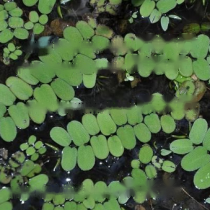
Chinese name: Sophora japonica
Latin name: Salvinia natans L.All
Order: Sophora japonica
Family: Sophoraceae
Genus: Sophora
1. Morphological characteristics of Sophora japonica
The aquatic plant of Sophora japonica floating on the water surface , the stem is horizontal and slender, almost rootless, covered with brown nodular short hairs, three whorled leaves, two floating on the water surface, one thinner forming a false root in the water, covered with coarse hairs, the water surface leaves on the stem The two sides are arranged in parallel, exactly like locust leaves, with gray-white markings on the surface, oval or oblong, obtuse at the top, and heart-shaped at the base.
2. Habits of Sophora japonica
Sophora japonica likes a sunny growth environment, but the leaves are sparsely arranged in insufficient light. It grows at a suitable temperature of 20℃-35℃, and is resistant to high temperature High humidity, but over 35°C, the plants grow poorly and are not cold-resistant. When the temperature is lower than 10°C, the plants stop growing and are even susceptible to freezing damage. There are no strict requirements for water quality. Generally, the water quality of ponds and streams can grow, and they like warmth.
3. The value of Sophora japonica
Sophora japonicae mainly has medicinal value. According to the National Chinese Herbal Medicine Compilation, the whole plant can be used as medicine and can be harvested all year round. Harvest, can be used directly fresh or sun-dried, the plant is pungent and cold, mainly for clearing away heat and detoxifying, promoting blood circulation and relieving pain. It is used to treat diseases such as carbuncle, bruises, swelling and pain, burns and scalds, but an appropriate amount is required for external use.
Guess you like it
FishXingcao| Rush | Mushroom | Wildflower | Hornwort|
Duckweed | Cattail | Three white grass| Yellow calamus| Water bamboo leaf|
Dai| Da Ping| black algae| Taro| Corydalis| Wild fern|Kidney fern| | Mosaic Reed Bamboo | Asparagus | Crossing the PondSnake| Sleeping Vegetables |
![[Dog Training 5] The training method of pet dog dining etiquette](/static/img/12192/12192_1.jpg)




